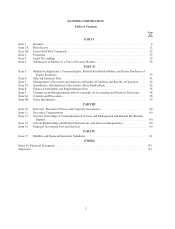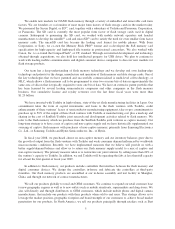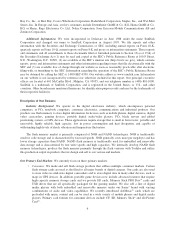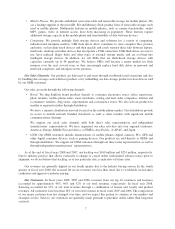SanDisk 2008 Annual Report Download - page 17
Download and view the complete annual report
Please find page 17 of the 2008 SanDisk annual report below. You can navigate through the pages in the report by either clicking on the pages listed below, or by using the keyword search tool below to find specific information within the annual report.
• inability to match our captive memory output to overall market demand for our products, which could
result in write-downs for excess inventory, lower of cost or market reserves, fixed costs associated with
our investments, restructuring of our joint ventures with Toshiba, or other actions;
• inability to complete the restructuring transactions with Toshiba announced on January 29, 2009 in a
timely manner, or at all;
• increased memory component and other costs as a result of currency exchange rate fluctuations to the
U.S. dollar, particularly with respect to the Japanese yen;
• inability to reduce operating expenses to reflect the current environment while continuing to invest in
future technologies and products;
• expansion of supply from existing competitors and ourselves creating excess market supply, causing
our average selling prices to decline faster than our costs;
• inability to develop or unexpected difficulties or delays in developing or manufacturing with
acceptable yields, X3, X4, 3D Read/Write, or other advanced, alternative technologies or difficulty in
bringing advanced technologies such as 32-nanometer NAND flash memory into volume production at
cost competitive levels;
• increased purchases of non-captive flash memory, including due to our plan to restructure and slow the
growth of captive capacity, which typically costs more than captive flash memory and may be of less
consistent quality;
• unpredictable or changing demand for our products, particularly demand for certain types or capacities
of our products or for our products in certain markets or geographies;
• difficulty in forecasting and managing inventory levels due to noncancelable contractual obligations to
purchase materials, such as custom non-memory materials, and the need to build finished product in
advance of customer purchase orders;
• timing, volume and cost of wafer production from Flash Ventures as impacted by fab start-up delays
and costs, technology transitions, yields or production interruptions;
• disruption in the manufacturing operations of suppliers, including suppliers of sole-sourced
components;
• potential delays in the emergence of new markets and products for NAND-based flash memory and
acceptance of our products in these markets;
• timing of sell-through and the financial liquidity of our distributors and retail customers;
• errors or defects in our products caused by, among other things, errors or defects in the memory or
controller components, including memory and non-memory components we procure from third-party
suppliers;
• write-downs or impairments of our investments in fabrication capacity, equity investments and other
assets;
• impairment of intangible assets related to our acquisitions;
• insufficient assembly and test capacity from our Shanghai facility or our contract manufacturers; and
• other factors described under “Risk Factors” and elsewhere in this report.
Competitive pricing pressures and excess supply have resulted in lower average selling prices and negative
product gross margin which may continue and if we do not experience adequate price elasticity, our revenues
may continue to decline. The NAND flash memory industry is currently in the midst of a severe downturn,
13
























